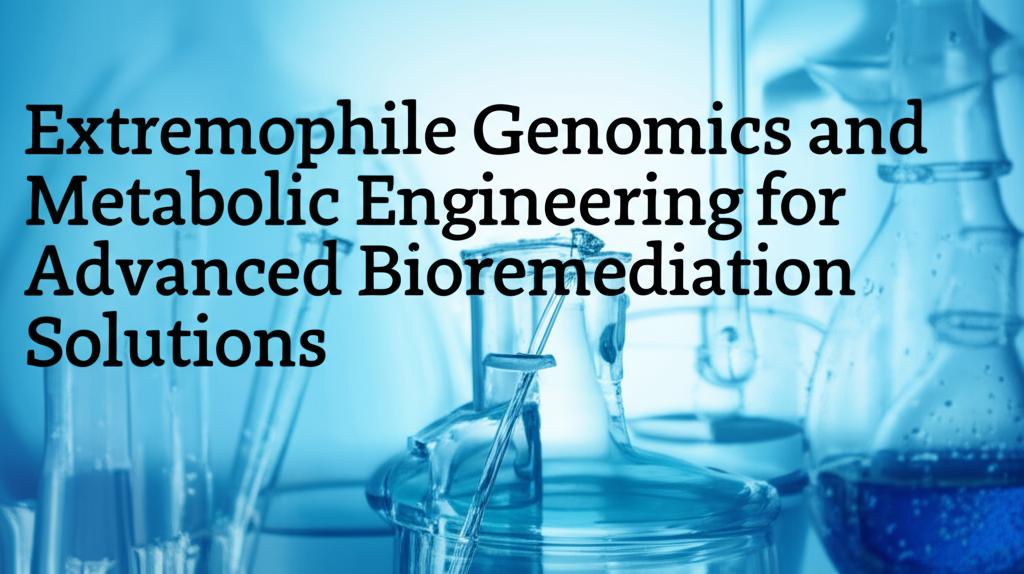Extremophiles, microorganisms that thrive in environments considered inhospitable to most life forms, are at the forefront of innovative bioremediation strategies. Their remarkable ability to tolerate and transform pollutants under harsh conditions – such as extreme temperatures, pH levels, salinity, and high concentrations of toxic substances – makes them invaluable tools for cleaning up contaminated sites. The integration of genomics and metabolic engineering is unlocking even greater potential for these unique organisms in advanced bioremediation solutions.
Harnessing Extremophile Diversity for BioremediationExtremophiles have evolved unique metabolic pathways and enzymes, known as extremozymes, that enable them to break down or neutralize a wide array of contaminants. These include heavy metals, organic compounds, radionuclides, and plastics. For instance:
- Thermophiles like Thermus aquaticus and Geobacillus stearothermophilus can degrade organic pollutants in high-temperature industrial waste.
- Halophiles such as Halomonas and Halobacterium species are effective in managing waste in saline environments, crucial for industries like oil extraction. Halomonas smyrnensis, for example, can reduce hexavalent chromium in saline conditions.
- Acidophiles like Ferroplasma acidarmanus and Acidithiobacillus ferrooxidans are used to address metal contaminants in acidic environments, often found in mining operations.
- Alkaliphiles such as Alcaligenes and Bacillus alcalophilus can treat pollutants in alkaline conditions common in various industrial processes.
- Psychrophiles, or cold-loving microbes like Pseudomonas psychrophila and Psychrobacter species, are valuable for bioremediation in cold environments.
Recent advancements in genomics, metagenomics, proteomics, and metabolomics – collectively known as "omics" technologies – have revolutionized our understanding of extremophiles. These tools allow scientists to:
- Identify and characterize novel extremophiles and their unique metabolic capabilities from previously unexplored extreme environments like deep-sea hydrothermal vents and polar ice caps.
- Uncover the genetic basis of their stress tolerance mechanisms and pollutant-degrading pathways.
- Mine genomes for novel enzymes (extremozymes) with enhanced stability and activity under extreme conditions. These enzymes are critical for industrial processes where conventional enzymes would fail.
- Understand complex microbial communities and their interactions in contaminated environments, paving the way for the development of effective microbial consortia for bioremediation.
Metabolic engineering takes this understanding a step further by enabling scientists to modify the genetic makeup of extremophiles to enhance their bioremediation capabilities. This can involve:
- Optimizing existing metabolic pathways to increase the rate and efficiency of pollutant degradation.
- Introducing new genetic pathways to enable the degradation of pollutants that the organism cannot naturally process.
- Improving the organism's tolerance to even more extreme conditions or higher concentrations of pollutants.
- Developing them as "microfactories" to not only clean up pollution but also to convert waste into valuable bioproducts like biofuels, bioplastics, and biochemicals, contributing to a circular bioeconomy.
Advanced techniques like Multivariate Modular Metabolic Engineering (MMME) and Multiplex Automated Genome Engineering (MAGE) are being utilized to modulate the metabolism of extremophiles for specific applications. Synthetic biology tools are also becoming increasingly adaptable for use in non-model organisms like extremophiles, facilitating the editing and modification of their genomes for biomanufacturing and enhanced bioremediation.
Challenges and Future DirectionsDespite significant progress, challenges remain. Many extremophiles are difficult to cultivate in laboratory settings, and their metabolic pathways can be complex and not fully understood. Optimizing their growth and production capabilities for industrial applications, often under less extreme and more economically viable conditions, requires further advancements in biotechnology and synthetic biology.
The future of extremophile research in bioremediation is promising. Continued exploration of extreme environments will undoubtedly reveal new organisms and novel biochemical pathways. Integrating omics data with computational modeling will provide deeper insights into their metabolic networks. Genetic and metabolic engineering, powered by tools like CRISPR-Cas, will continue to enhance their bioremediation prowess, leading to more efficient, sustainable, and cost-effective solutions for tackling environmental pollution. Extremophiles are not just fascinating from a biological perspective; they are pivotal agents in our quest for a cleaner and more sustainable planet.

